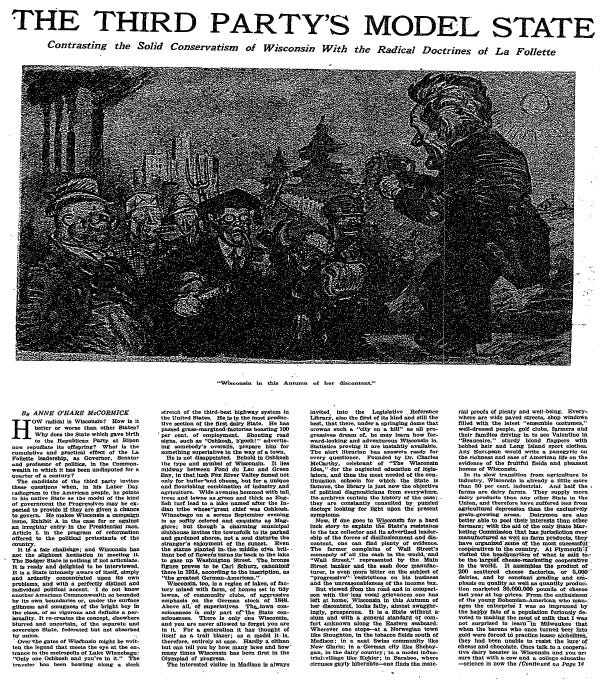The Third Party's Model State
In September 1924, shortly before Wisconsin Sen. Robert M. LaFollette would complete one of the top third-party presidential candidacies in American history, a New York Times Magazine article asked: what was it about Wisconsin?
Anne O'Hare McCormick wrote that the state was truly unique:
There is only one Wisconsin, and you are never allowed to forget you are in it. For a generation it has thought of itself as a trail blazer; as a model it is, therefore, entirely at ease. Hardly a citizen but can tell you by how many laws and how many times Wisconsin has been first in the Olympiad of progress.
Yet, McCormick notes, in a lot of ways LaFollette was all talk:
For thirty years under the influence of the leader who talks boldly of deflating the Supreme Court, nationalizing the railroads, abolishing the control of capital, this state has not taken the first step toward any one of these vaunted reforms. No part of America is so marked by the ideas of one man, [yet] no part of America appears to the passing observer to have been shaped into so stiff a pattern.
LaFollette would go on to win 4.8 million votes, or 16% of the national total. However, he only won 13 Electoral College votes, from his home state of Wisconsin where he emerged victorious with 54%.
LaFollette's top 10 states were:
Wisconsin = 54.0%
North Dakota = 45.2%
Minnesota = 41.3%
Montana = 37.9%
South Dakota = 37.0%
Idaho = 36.5%
Nevada = 36.3%
Washington = 35.8%
California = 33.1%
Wyoming = 31.5%
To this day, Wisconsin remains an outlier in American politics, though less for reasons of progressivism than for its razor-thin margins.
On a state level, it's one of only 10 states where the governor and legislature are split, in this case with Democratic Gov. Tony Evers but a Republican legislature.
On a Senate level, it's one of only seven states where the two senators represent different parties, in this case Democrat Tammy Baldwin and Republican Ron Johnson.
On a presidential level, Wisconsin is considered one of the seven main swing states for 2024, along with Arizona, Georgia, Michigan, Nevada, North Carolina, and Pennsylvania.
Although personally, I think everyone is sleeping on Texas. That's right, Texas. Its Republican margin has plummeted in recent years, it was the ninth-closest state in 2020, and I think it could even potentially be top five closest this time.
The Third Party's Model State: Contrasting the Solid Conservatism of Wisconsin With the Radical Doctrines of La Follette
Published: Sunday, September 28, 1924


